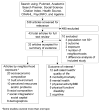Neighborhood environment in studies of health of older adults: a systematic review
- PMID: 19840702
- PMCID: PMC2785463
- DOI: 10.1016/j.amepre.2009.06.022
Neighborhood environment in studies of health of older adults: a systematic review
Abstract
Context: Epidemiologists and public health researchers are studying neighborhood's effect on individual health. The health of older adults may be more influenced by their neighborhoods as a result of decreased mobility. However, research on neighborhood's influence on older adults' health, specifically, is limited.
Evidence acquisition: Recent studies on neighborhood and health for older adults were identified. Studies were identified through searches of databases including PsycINFO, CINAHL, PubMed, Academic Search Premier, Ageline, Social Science Citation Index, and Health Source. Criteria for inclusion were as follows: human studies; English language; study sample included adults aged > or =55 years; health outcomes, including mental health, health behaviors, morbidity, and mortality; neighborhood as the primary exposure variable of interest; empirical research; and studies that included > or =10 neighborhoods. Air pollution studies were excluded. Five hundred thirty-eight relevant articles were published during 1997-2007; a total of 33 of these articles met inclusion criteria.
Evidence synthesis: The measures of objective and perceived aspects of neighborhood were summarized. Neighborhood was primarily operationalized using census-defined boundaries. Measures of neighborhood were principally derived from objective sources of data; eight studies assessed perceived neighborhood alone or in combination with objective measures. Six categories of neighborhood characteristics were socioeconomic composition, racial composition, demographics, perceived resources and/or problems, physical environment, and social environment. The studies are primarily cross-sectional and use administrative data to characterize neighborhood.
Conclusions: These studies suggest that neighborhood environment is important for older adults' health and functioning.
References
-
- UN Department of Economic and Social Affairs. World Population Ageing 2007. Department of Economic and Social Affairs PD, ed; UN: 2007. p. 516.
-
- Bureau USC. State and County QuickFacts. [Accessed October 3, 2006];
-
- Yen IH, Kaplan GA. Neighborhood social environment and risk of death: multilevel evidence from the Alameda County Study. American Journal of Epidemiology. 1999;149(10):898–907. - PubMed
-
- Borrell LN, Diez Roux AV, Rose K, Catellier D, Clark BL. Neighbourhood characteristics and mortality in the Atherosclerosis Risk in Communities Study. Int J Epidemiol. 2004 Apr;33(2):398–407. - PubMed
-
- Winkleby M, Cubbin C, Ahn D. Excess Mortality among Low SES People Living in High SES Neighborhoods: Results of a 17-Year Follow-up Study American. Journal of Public Health. in press.
Publication types
MeSH terms
Grants and funding
LinkOut - more resources
Full Text Sources
Miscellaneous


